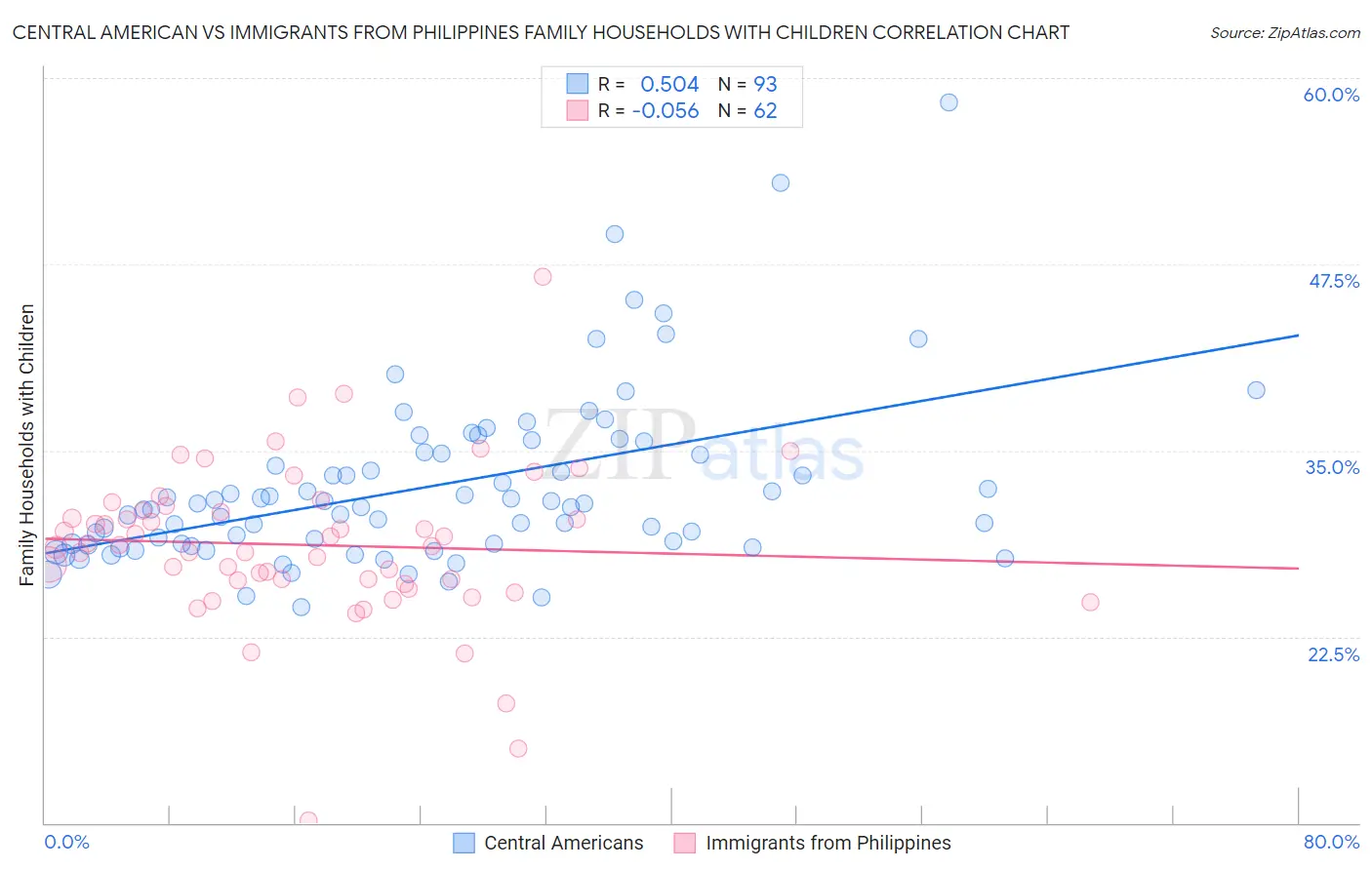Central American vs Immigrants from Philippines Family Households with Children
COMPARE
Central American
Immigrants from Philippines
Family Households with Children
Family Households with Children Comparison
Central Americans
Immigrants from Philippines
29.1%
FAMILY HOUSEHOLDS WITH CHILDREN
100.0/ 100
METRIC RATING
40th/ 347
METRIC RANK
29.0%
FAMILY HOUSEHOLDS WITH CHILDREN
100.0/ 100
METRIC RATING
46th/ 347
METRIC RANK
Central American vs Immigrants from Philippines Family Households with Children Correlation Chart
The statistical analysis conducted on geographies consisting of 503,865,600 people shows a substantial positive correlation between the proportion of Central Americans and percentage of family households with children in the United States with a correlation coefficient (R) of 0.504 and weighted average of 29.1%. Similarly, the statistical analysis conducted on geographies consisting of 470,847,260 people shows a slight negative correlation between the proportion of Immigrants from Philippines and percentage of family households with children in the United States with a correlation coefficient (R) of -0.056 and weighted average of 29.0%, a difference of 0.47%.

Family Households with Children Correlation Summary
| Measurement | Central American | Immigrants from Philippines |
| Minimum | 24.5% | 10.2% |
| Maximum | 58.3% | 46.7% |
| Range | 33.8% | 36.5% |
| Mean | 32.6% | 28.7% |
| Median | 31.2% | 28.6% |
| Interquartile 25% (IQ1) | 28.7% | 26.3% |
| Interquartile 75% (IQ3) | 34.8% | 31.0% |
| Interquartile Range (IQR) | 6.1% | 4.7% |
| Standard Deviation (Sample) | 5.8% | 5.4% |
| Standard Deviation (Population) | 5.8% | 5.4% |
Demographics Similar to Central Americans and Immigrants from Philippines by Family Households with Children
In terms of family households with children, the demographic groups most similar to Central Americans are Yaqui (29.1%, a difference of 0.010%), Immigrants from South Eastern Asia (29.1%, a difference of 0.090%), Spanish American Indian (29.1%, a difference of 0.090%), Korean (29.2%, a difference of 0.16%), and Asian (29.1%, a difference of 0.28%). Similarly, the demographic groups most similar to Immigrants from Philippines are Peruvian (29.0%, a difference of 0.010%), Apache (29.0%, a difference of 0.040%), Fijian (29.0%, a difference of 0.090%), Jordanian (29.0%, a difference of 0.13%), and Immigrants from Taiwan (29.0%, a difference of 0.14%).
| Demographics | Rating | Rank | Family Households with Children |
| Venezuelans | 100.0 /100 | #33 | Exceptional 29.4% |
| Immigrants | Bolivia | 100.0 /100 | #34 | Exceptional 29.3% |
| Immigrants | Sierra Leone | 100.0 /100 | #35 | Exceptional 29.3% |
| Immigrants | Venezuela | 100.0 /100 | #36 | Exceptional 29.3% |
| Immigrants | Cameroon | 100.0 /100 | #37 | Exceptional 29.2% |
| Koreans | 100.0 /100 | #38 | Exceptional 29.2% |
| Yaqui | 100.0 /100 | #39 | Exceptional 29.1% |
| Central Americans | 100.0 /100 | #40 | Exceptional 29.1% |
| Immigrants | South Eastern Asia | 100.0 /100 | #41 | Exceptional 29.1% |
| Spanish American Indians | 100.0 /100 | #42 | Exceptional 29.1% |
| Asians | 100.0 /100 | #43 | Exceptional 29.1% |
| Immigrants | Taiwan | 100.0 /100 | #44 | Exceptional 29.0% |
| Fijians | 100.0 /100 | #45 | Exceptional 29.0% |
| Immigrants | Philippines | 100.0 /100 | #46 | Exceptional 29.0% |
| Peruvians | 100.0 /100 | #47 | Exceptional 29.0% |
| Apache | 100.0 /100 | #48 | Exceptional 29.0% |
| Jordanians | 100.0 /100 | #49 | Exceptional 29.0% |
| Immigrants | Immigrants | 100.0 /100 | #50 | Exceptional 28.9% |
| Immigrants | Peru | 100.0 /100 | #51 | Exceptional 28.9% |
| Guatemalans | 100.0 /100 | #52 | Exceptional 28.9% |
| Immigrants | Cambodia | 100.0 /100 | #53 | Exceptional 28.9% |